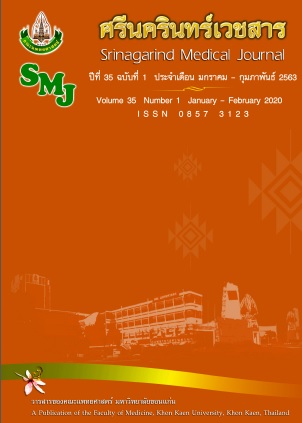Prevalence of Clinical Lumbar Instability in Patients with Chronic Low Back Pain by Radiography (Pilot Study)
Keywords:
Prevalence; Low back pain; lumbar instability;, X-rayAbstract
Background and Objective: Lumbar Instability (LI) could be classified into many subgroups which Clinical Lumbar Instability (CLI) was considered as affected on patients. CLI defined as the translation and rotation values of each lumbar segment greater than normal translation and rotation with clinical sign. CLI could result in patients in many aspects which had been reported. However, the evidence on reporting of lumbar instability have different methodology. The aimed of this study was to report CLI in patients with chronic low back pain by radiography.
Methods: This was a cross-sectional descriptive study in 50 chronic low back pain (CLBP) participants aged 33.7±13.3 years. Data were collected by interview for demographic data and flexion-extension radiograph for diagnosis instability. Descriptive statistics were used for calculation.
Results: This study found that the amount of CLI was 92%. Age of participants with CLI range from 20-59, which the participant aged 30 to 39 and 50 to 59 years showed 100% of CLI, aged 20 to 29 and 40 to 49 years showed 93.3% and 66.7%, respectively.
Conclusions: The finding of prevalence, age, and LBP period in this study demonstrated that CLI could be occurred in people who aged from 20 years onward. There were young patients with CLBP, the practitioner should aware of assessment about CLI in order to providing suitable management.
References
2. Deyo RA, Weinstein JN. Low back pain. N Engl J Med 2001; 344: 363-70. Review.
3. Vanti C, Conti C, Feresin F, Ferrari S, Piccarreta R. The relationship between clinical instability and endurance test, pain, and disability in nonspecific low back pain. J Manipulative Physiol Ther 2016; 39: 359-68.
4. Panjabi MM. The stabilizing system of the spine. Part II. Neutral zone and instability hypothesis. J Spinal Disord 1992; 5: 390-6.
5. Abbott JH, McCane B, Herbison P, Moginie G, Chapple C, Hogarty T. Lumbar segmental instability: a criterion-related validity study of manual therapy assessment. BMC Musculoskelet Disord 2005; 6: 56.
6. Panjabi MM. The stabilizing system of the spine. Part I. Function, dysfunction, adaptation, and enhancement. J Spinal Disord 1992; 5: 383-9.
7. รุ้งทิพย์ พันธุเมธากุล. กายภาพบำบัดในภาวะหลังส่วนล่างหลวม. พิมพ์ครั้งที่ 1. ขอนแก่น: คณะเทคนิคการแพทย์ มหาวิทยาลัยขอนแก่น, 2561.
8. Cook C, Brismée JM, Sizer PS Jr. Subjective and objective descriptors of clinical lumbar spine instability: a Delphi study. Man Ther 2006; 11: 11-21.
9. Fritz JM, Piva SR, and Childa JD. Accuracy of the clinical examination to predict radiologic instability of the lumbar spine. Eur Spine J 2005; 14: 743-50.
10. Iguchi T, Kanemura A, Kasahara K, Kurihara A, Doita M, Yoshiya S. Age distribution of three radiologic factors for lumbar instability: probable aging process of the instability with disc degeneration. Spine (Phila Pa 1976) 2003; 28: 2628-33.
11. White AA, Panjabi MM. Clinical biomechanics of the spine, 2nd edition. Lippincott, Philadelphia, 1990; 23–45.
12. Staub BN, Holman PJ, Reitman CA, Hipp J. Sagittal plane lumbar intervertebral motion during seated flexion-extension radiographs of 658 asymptomatic nondegenerated levels. J Neurosurg Spine 2015; 23: 731-8.
13. Puntumetakul R, Yodchaisarn W, Emasithi A, Keawduangdee P, Chatchawan U, Yamauchi J. Prevalence and individual risk factors associated with clinical lumbar instability in rice farmers with low back pain. Patient Prefer Adherence 2014; 9: 1-7.
14. Puntumetakul R, Trott P, Williams M, Fulton I. Effect of time of day on the vertical spinal creep response. Appl Ergon 2009; 40: 33-8.
15. Faucett J. Chronic low back pain: early interventions. Annu Rev Nurs Res 1999; 17: 155-82.




